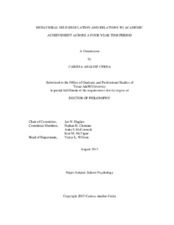| dc.description.abstract | Research demonstrates that behavioral self-regulation (BSR) serves as a concurrent, explanatory factor of academic achievement in various elementary grades, and that kindergarten BSR predicts growth in academic achievement across elementary grades. Despite these findings, important aspects of the association between BSR and academic achievement remain under-studied. Few studies have simultaneously investigated developmental changes in BSR and academic achievement. Thus, using an academically at-risk sample and an empirically validated, multi-source measure of BSR, this dissertation investigates whether initial level of BSR in first grade predicts initial level and growth in academic achievement across grades 1 to 4, and whether growth in BSR across grades 1 to 4 predicts growth in academic achievement across that same time span. Longitudinal growth curve modeling (LGCM) was used to obtain growth trajectories for BSR, reading, and math across grades 1 to 4. Structural equation modeling (SEM) was used to investigate the effect of BSR in grade 1 on reading and math in grade 1, and on growth in reading and math from grades 1 to 4. SEM was also used to investigate the impact of growth in BSR on growth in reading and math from grades 1 to 4.
Participants included 745 students. BSR was measured by peer ratings obtained via sociometric interviews and by teacher ratings on well-validated questionnaires. Reading and math were assessed with an individually administered standardized measure. LGCM results demonstrated linear growth in BSR and quadratic growth in reading and math. Although average levels of BSR in first grade were zero and on average, BSR presented a flat linear slope, individual differences existed in first grade BSR and in BSR across grades 1 to 4. Additionally, statistical significance was found for the average intercept and quadratic slope of reading and math, and individual differences were present in first grade reading and math. SEM results revealed that first grade BSR significantly predicted first grade reading and math achievement, above relevant demographic covariates; however, first grade BSR and linear growth in BSR did not significantly predict quadratic growth in reading or math. Limitations and implications for research and intervention are discussed. | en |


